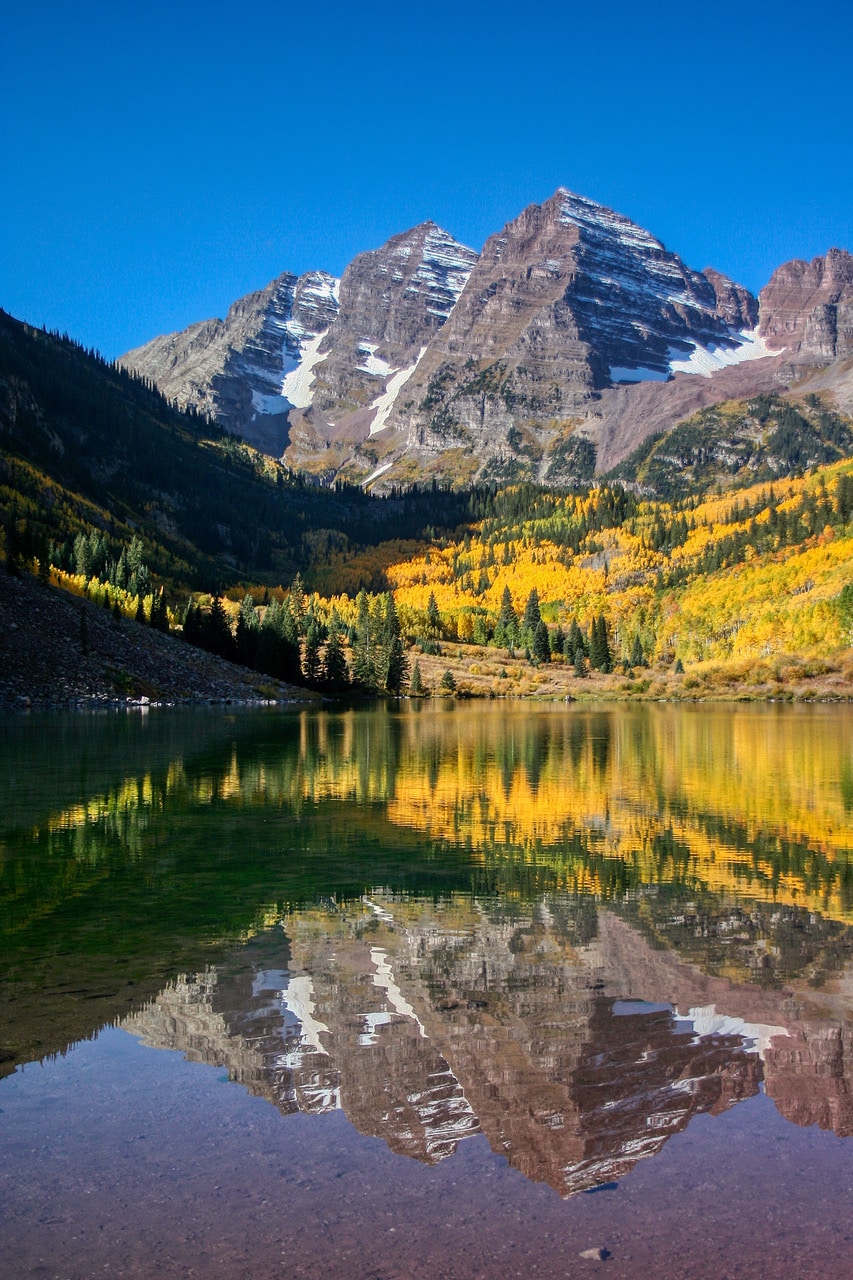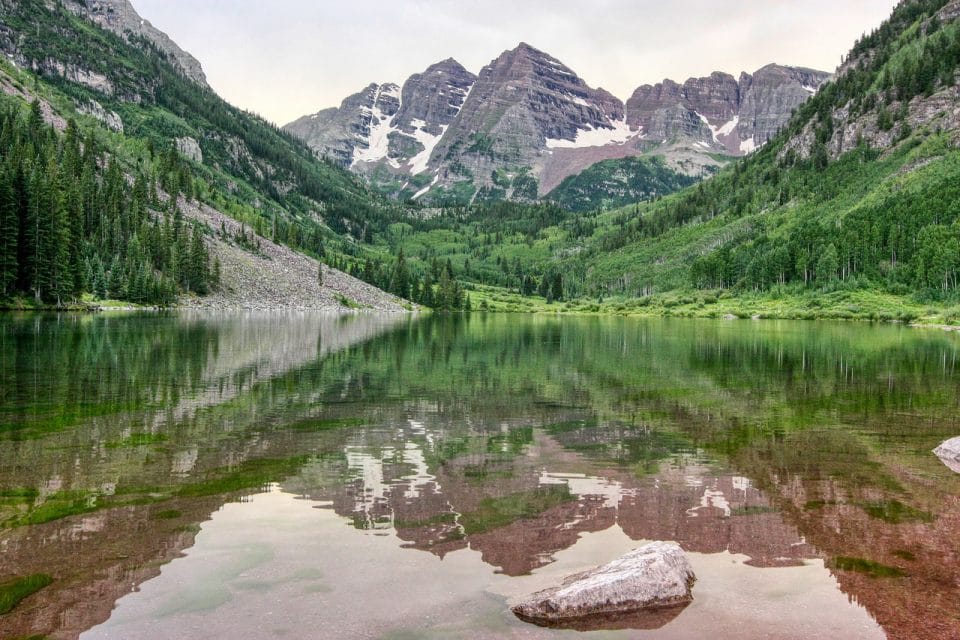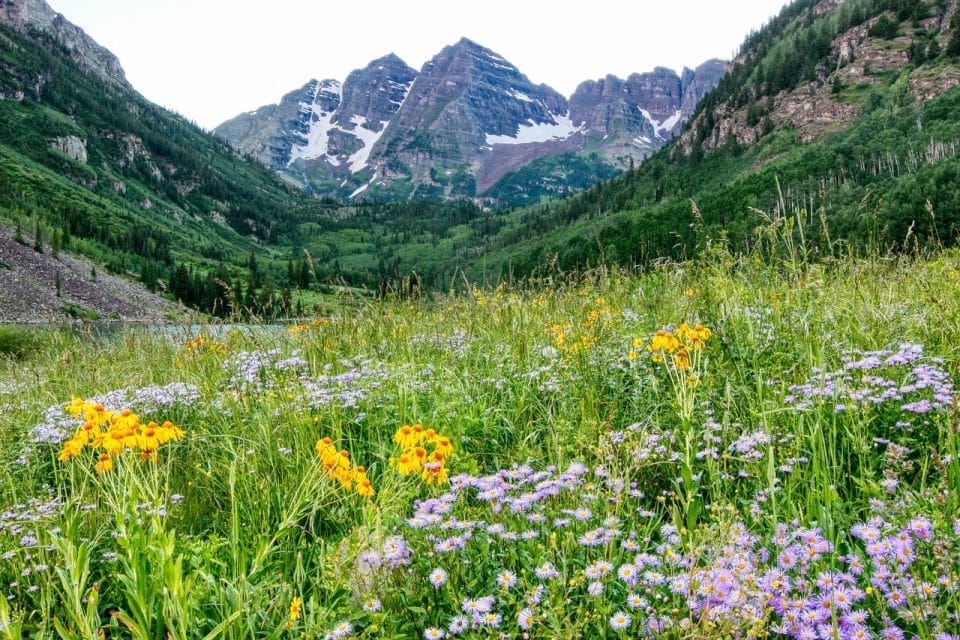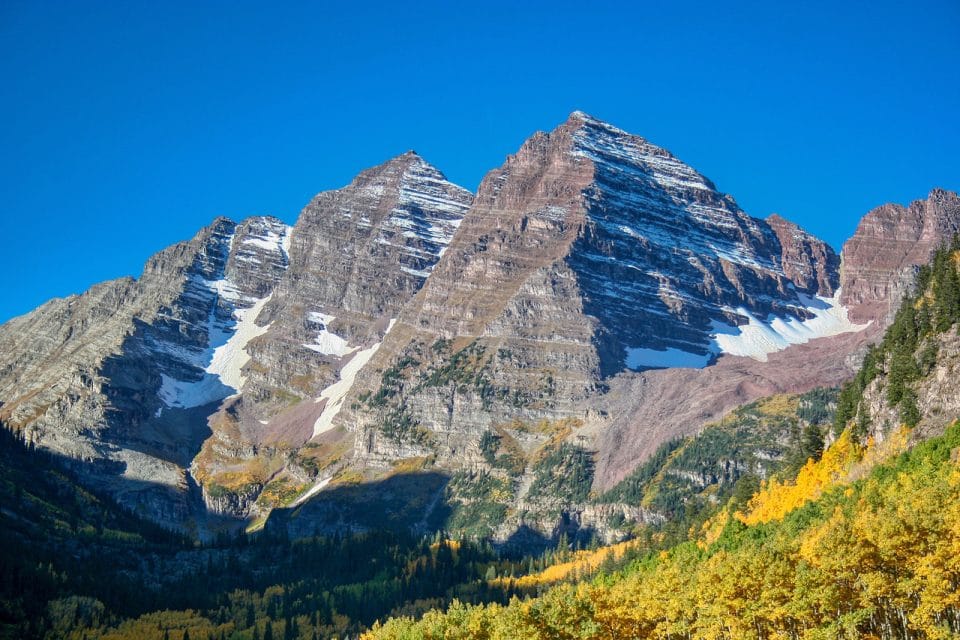 Before actual sunrise, photographers rush to set up their tripods and prepare for the morning photo shoot at the Maroon Bells near Aspen, Colo. Due to huge numbers of visitors, one should check with the Aspen Chamber of Commerce for the latest restrictions before visiting the area. Photo by Gary Warren/ladailypost.com
Before actual sunrise, photographers rush to set up their tripods and prepare for the morning photo shoot at the Maroon Bells near Aspen, Colo. Due to huge numbers of visitors, one should check with the Aspen Chamber of Commerce for the latest restrictions before visiting the area. Photo by Gary Warren/ladailypost.com
 About two or three hours after sunrise, the September breezes ceased and the Maroon Bells reflected into Maroon Lake. The lake sits at about 9,600 feet while each of the Maroon Peaks are over 14,000 feet in elevation. This is what every visitor to the Maroon Bells hopes to see and photograph. Photo by Gary Warren/ladailypost.com
About two or three hours after sunrise, the September breezes ceased and the Maroon Bells reflected into Maroon Lake. The lake sits at about 9,600 feet while each of the Maroon Peaks are over 14,000 feet in elevation. This is what every visitor to the Maroon Bells hopes to see and photograph. Photo by Gary Warren/ladailypost.com
By GARY WARREN
Photographer
Formerly of Los Alamos
Located in the White River National Forest near Aspen, Colo. stand the most photographed mountains in Colorado. Some consider the Maroon Bells the most photographed mountains in all of North America. The peaks are in the Maroon Bells-Snowmass Wilderness Area within the White River National Forest.
South Maroon Peak and North Maroon Peak sit about a third of a mile apart and make up the Maroon Bells. The peaks are a wine or maroon color and each peak is shaped like a bell giving them their name. Both peaks are “fourteeners” meaning that the peaks exceed 14,000 feet in elevation. South Maroon Peak is 14,163 feet and North Maroon Peak is 14,019 feet in elevation.
The craggy slopes of both mountains are made up of mudstone, which is a weak and loosely formed rock that fractures easily. This makes for dangerous mountain climbing conditions and only experienced, expert climbers should attempt the climb without consulting an experienced guide.
Maroon Lake sits at the base of the two majestic peaks as you view from the Maroon Creek Valley. This small lake at almost 9,600 feet allows the Maroon Bells to reflect in the still water when there is no wind to create ripples. Stands of aspen cover the hillsides by the lake embellishing this beautiful work of nature.
The Maroon Bells and Maroon Lake are an easy 12-mile drive from Aspen making the Maroon Bells Scenic Area even more popular. The area sees about 300,000 visitors every year, which has made a shuttle bus a requirement to enter the area in the busy season from May through October. However, visitors can drive into the area during the sunrise time frame, which is the best time to photograph the peaks.
Due to the enormous popularity of the area, visitors should contact the Aspen Chamber of Commerce to get the latest visitation restrictions. There is a cost for the shuttle bus as well as a cost to enter the scenic area and these figures change from season to season and certainly yearly. That being said, prepare accordingly and plan to experience some of the most beautiful and most photographed scenery in the country.
Editor’s note: Longtime Los Alamos photographer Gary Warren and his wife Marilyn are traveling around the country, and he shares his photographs, which appear in the “Posts from the Road” series published in the Sunday edition of the Los Alamos Daily Post.
 The Maroon Bells reflect in Maroon Lake during a slightly overcast summer sunrise. There was a slight breeze that July morning, which caused the lake water to ripple but not enough to ruin the reflection. The aspen trees covering the landscape were showing off their summer green. Photo by Gary Warren/ladailypost.com
The Maroon Bells reflect in Maroon Lake during a slightly overcast summer sunrise. There was a slight breeze that July morning, which caused the lake water to ripple but not enough to ruin the reflection. The aspen trees covering the landscape were showing off their summer green. Photo by Gary Warren/ladailypost.com
 The meadows around the Maroon Bells explode in colorful blooms during July. By late July or early August morning temperatures begin affecting the color and growth of the wildflowers making for a short season of maximum blooms. Photo by Gary Warren/ladailypost.com
The meadows around the Maroon Bells explode in colorful blooms during July. By late July or early August morning temperatures begin affecting the color and growth of the wildflowers making for a short season of maximum blooms. Photo by Gary Warren/ladailypost.com
 The first light of day finds the top of the peaks during a clear September sunrise. Unfortunately, during the early morning hours this day there was a strong breeze, which prevented any reflection of the peaks in Maroon Lake. That would change a few hours later that morning. Photo by Gary Warren/ladailypost.com
The first light of day finds the top of the peaks during a clear September sunrise. Unfortunately, during the early morning hours this day there was a strong breeze, which prevented any reflection of the peaks in Maroon Lake. That would change a few hours later that morning. Photo by Gary Warren/ladailypost.com
 A medium power zoom lens allows for a closer view of the two peaks at Maroon Bells Scenic Area. Most aspen trees in the area were already golden in color but some trees continue to cling to their summer green color. Photo by Gary Warren/ladailypost.com
A medium power zoom lens allows for a closer view of the two peaks at Maroon Bells Scenic Area. Most aspen trees in the area were already golden in color but some trees continue to cling to their summer green color. Photo by Gary Warren/ladailypost.com

